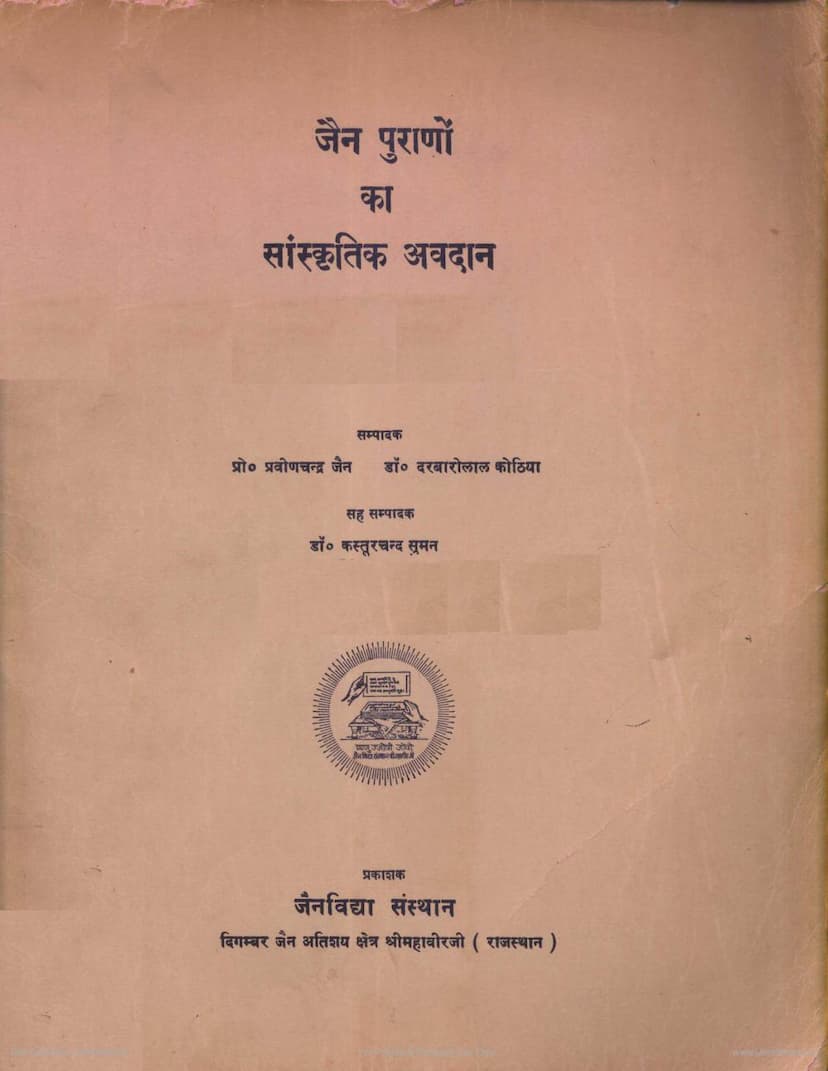Jain Purano Ka Sanskrutik Aavdan
Added to library: September 2, 2025

Summary
The book "Jain Purano ka Sanskrutik Avdan" (Cultural Contribution of Jain Puranas), edited by Prof. Pravinchandra Jain and Dr. Darbarilal Kothiya, with Dr. Kasturchand Suman as co-editor, published by Jain Vidyasansthan Rajasthan, is a comprehensive compilation of the cultural aspects found in Jain Puranas. The book aims to present the philosophical, religious, geographical, and historical material contained within these ancient narratives to scholars and the general public alike.
The preface and editorial sections highlight that Jain Puranas are considered mirrors of Jain culture and history. They are defined as ancient narratives that describe the lives and deeds of Shalaka Purushas (Distinguished Personalities). These are a total of sixty-three such individuals, comprising:
- 24 Tirthankaras: Spiritual guides who have attained liberation and teach the path to moksha (salvation).
- 12 Chakravartis: Universal monarchs who rule across vast territories.
- 9 Balabhadras: Powerful figures who uphold righteousness.
- 9 Narayanas: Prominent heroes in Jain mythology.
- 9 Pratinarayanas: Antagonists or opposing forces.
The book is structured into three main sections:
-
Philosophical and Religious Material: This section delves into the core tenets of Jainism as presented in the Puranas. It includes discussions on the existence of the soul, the teachings of ascetics, the principles of dharma, and the path to moksha. The Puranas explain that liberation is the ultimate goal, and worldly pursuits are merely means to achieve it. They illustrate the cycle of karma, suffering, and the possibility of attaining salvation through devotion, penance, and adherence to the Ratnatraya (three jewels: right faith, right knowledge, and right conduct). The narratives emphasize the transformation from an ordinary being to a divine one (like becoming a Narayana).
-
Geographical Material: This part focuses on the descriptions of various geographical entities mentioned in the Puranas. It includes details about continents, oceans, countries, cities, villages, rivers, mountains, forests, and lakes. The book notes that understanding these geographical descriptions is crucial for a true appreciation of the cultural context within which these stories unfold. It also acknowledges that geographical landscapes change over time, making the Puranas valuable for understanding past locations and their potential current locations for research purposes.
-
Historical Material: This section explores the historical and societal aspects depicted in the Puranas. It covers information about weapons and warfare, attire and ornaments, the lineage of prominent dynasties (like the Ikshvaku, Kuru, and Surya dynasties), the importance of knowledge and education, and the social customs of the time. The Puranas are presented as a repository of information that helps in understanding our ancestors, their values, the weapons used in battles, musical instruments, and the adornments worn by men and women, including their names. The Puranas also contain the 108 names of Vrishabhadeva and the 100 sons of Dhritarashtra, offering a glimpse into the rich historical tapestry.
The book emphasizes that the ultimate goal of a cultured life is to refine the body, mind, and soul, leading to the attainment of the highest life values. The Puranic narratives are seen as providing the inspiration and guidance for such a transformation.
The extensive appendix provides a detailed index and cross-references, listing numerous concepts, figures, places, and items discussed within the Jain Puranas. This includes:
- Future Purushas: Lists of future Tirthankaras, Chakravartis, Balabhadras, Narayanas, Pratinarayanas, and Rudras, as described in Mahapurana and Harivamsapurana.
- Virtues and Practices: Details on the virtues of Arhats, various practices (kriyas), supernatural powers (riddhis), karmic predispositions (karma prakritiya), important disciples (ganadharas), stages of spiritual progress (gunasthanas), various divisions of knowledge (shrutabheda), and different types of devotees.
- Cosmological and Geographical Details: Extensive lists of continents, islands, oceans, mountains, rivers, cities, countries, and forests.
- Historical Figures and Lineages: Genealogies of prominent dynasties such as the Ikshvaku, Kuru, Somavansha, and Suryavansha, and lists of kings and prominent individuals.
- Warfare and Arts: Information on weapons, musical instruments, and various forms of artistic expression.
- Social Practices: Details on ornaments, jewelry, and societal customs.
- Specific Lists: Comprehensive lists of the 108 names of Vrishabhadeva as praised by Bharatesha, various emotions (bhavana), types of false views (mithyādr̥ṣṭi), qualities of liberated souls, types of yogas and ascetic stages (pratimā), vows and their transgressions, various types of divine beings (devabheda), meditation practices (dhyānabheda), penances (tapa), and the divisions of scriptures (shrutabheda).
In essence, "Jain Purano ka Sanskrutik Avdan" serves as an encyclopedic reference to the cultural richness embedded within Jain Puranic literature, making these profound narratives accessible and understandable to a wider audience.